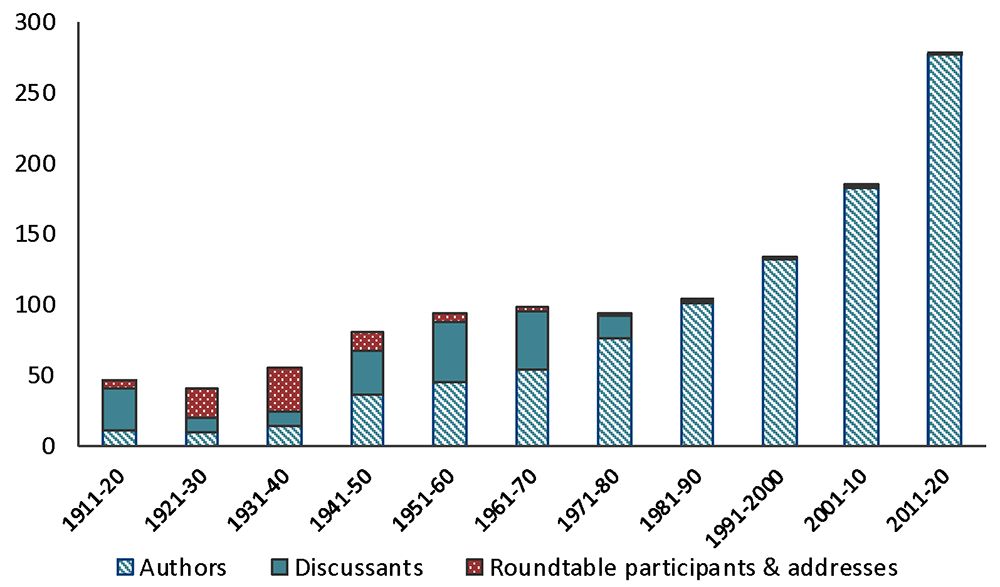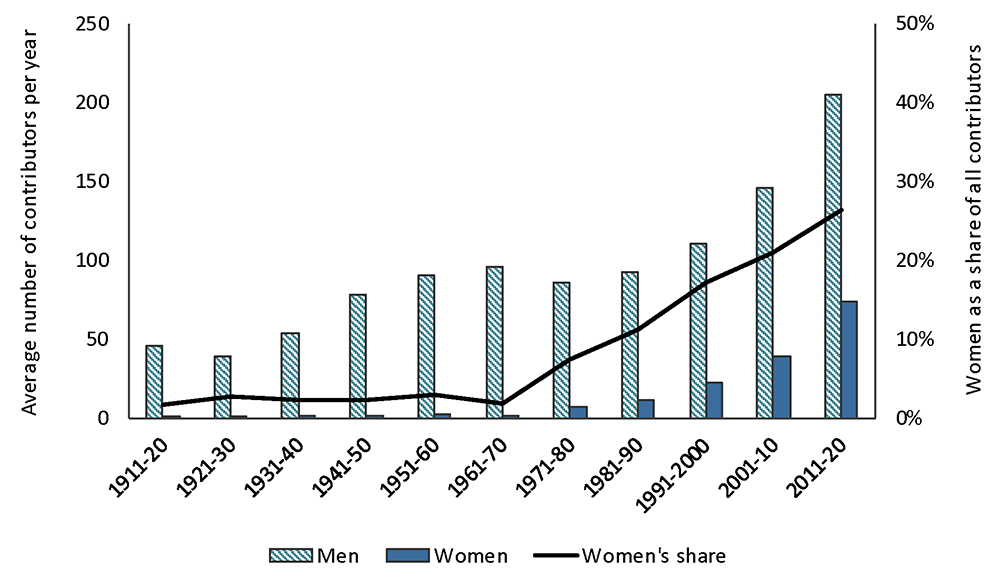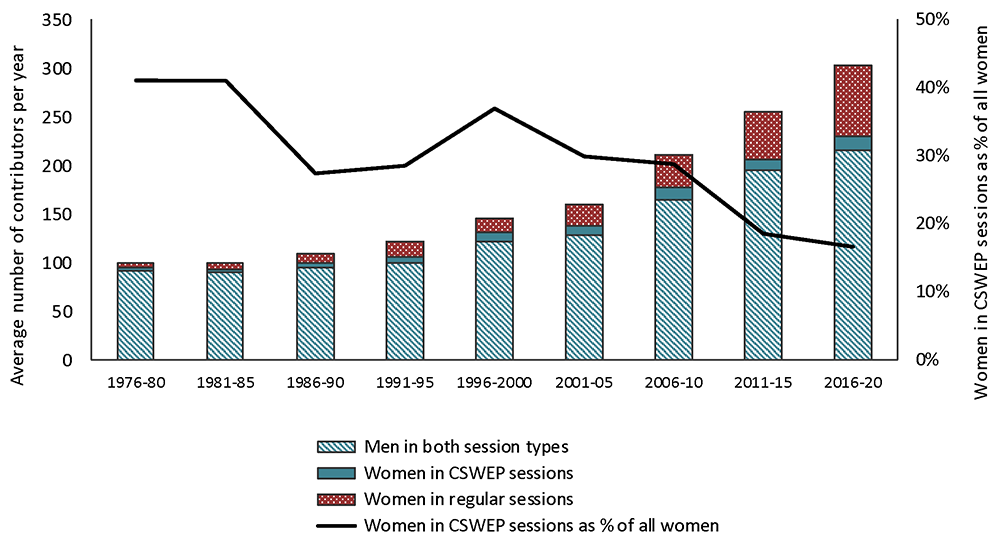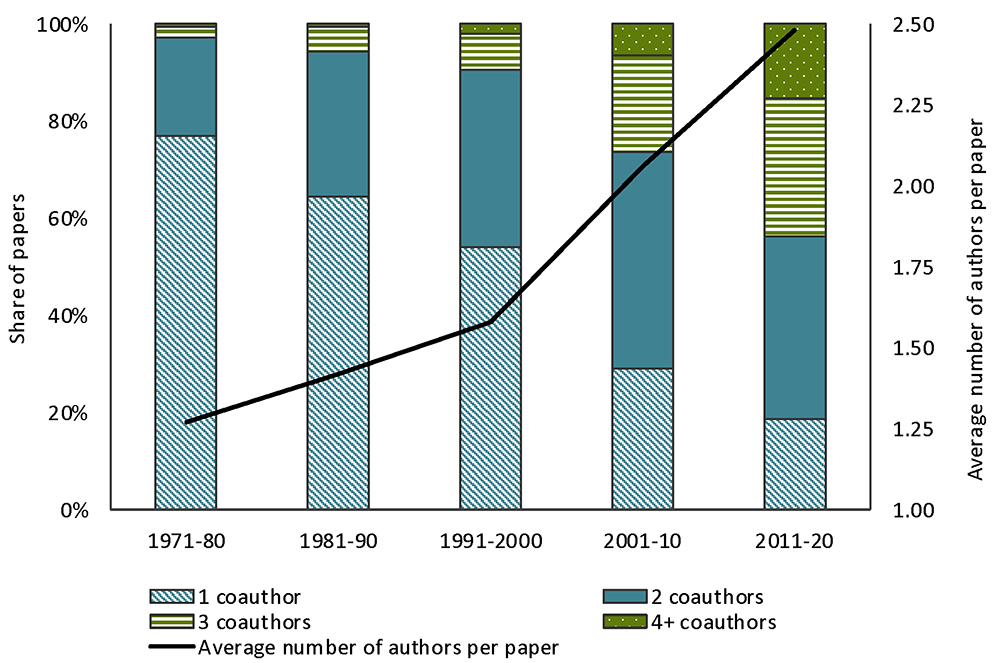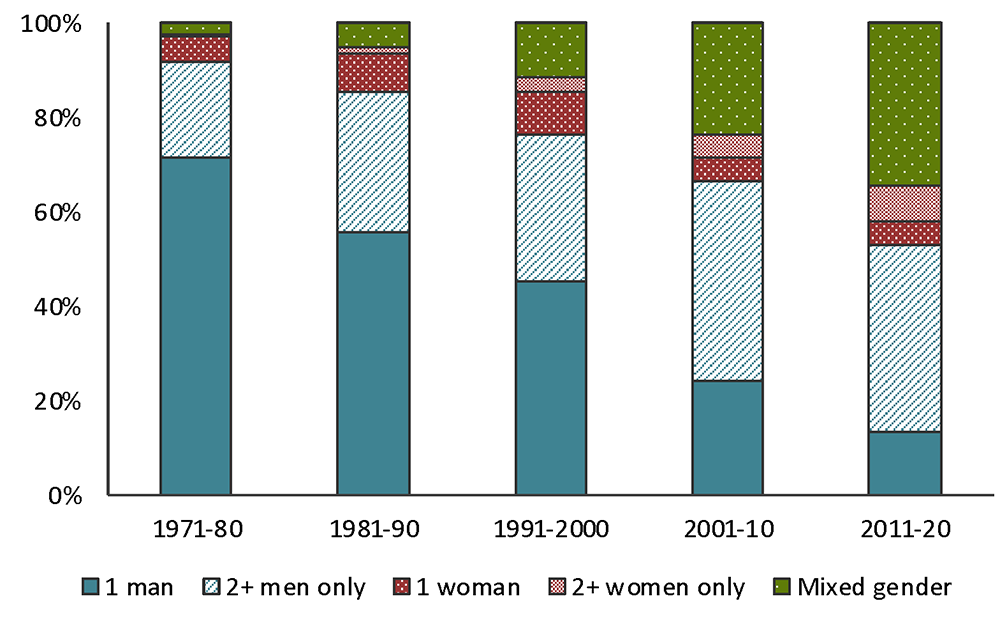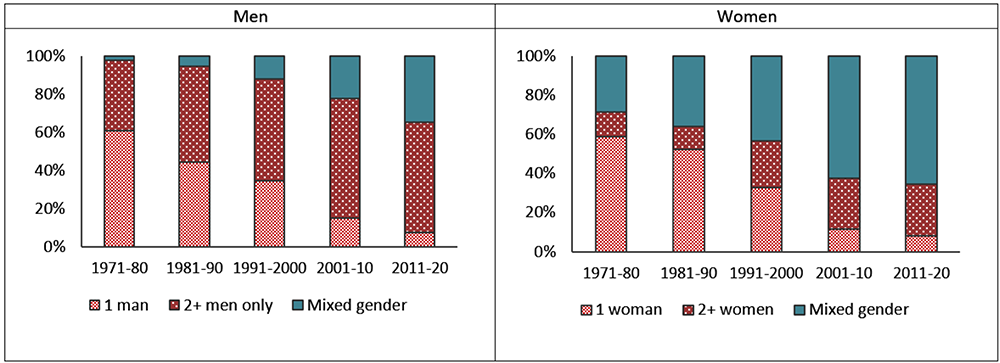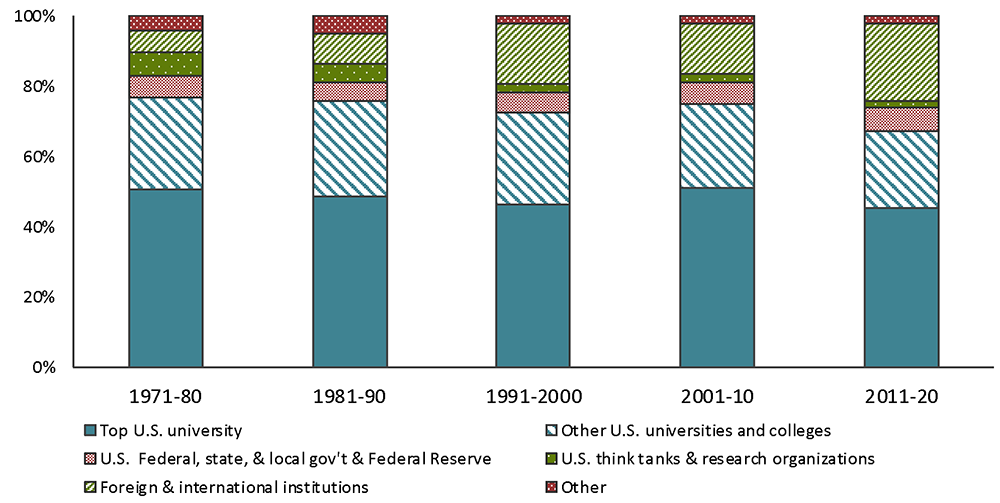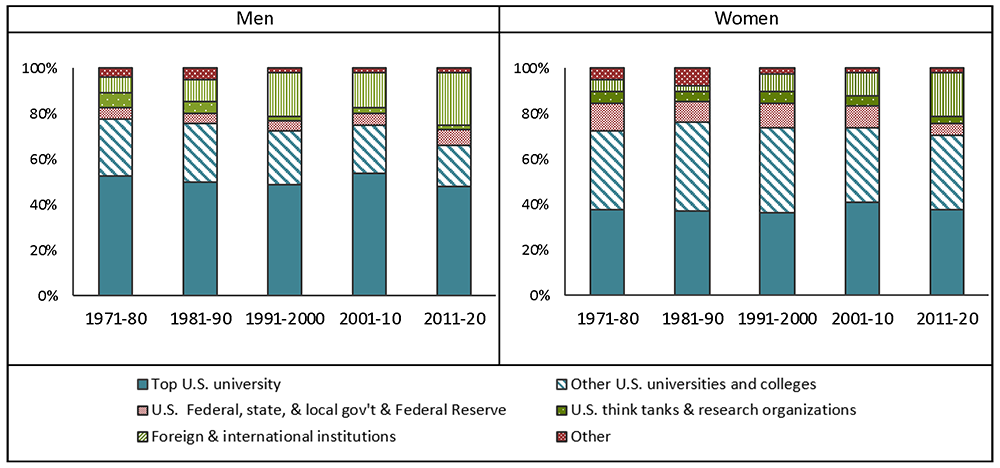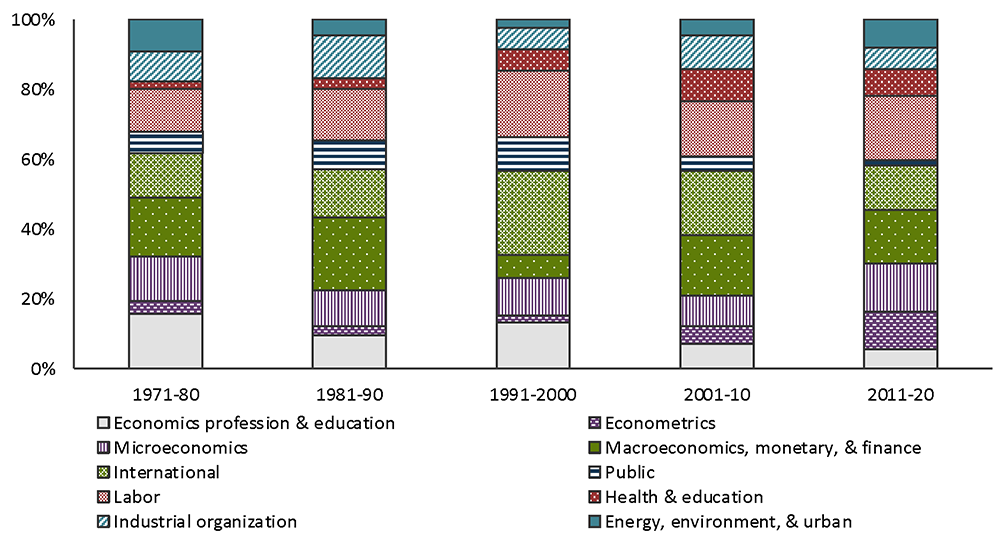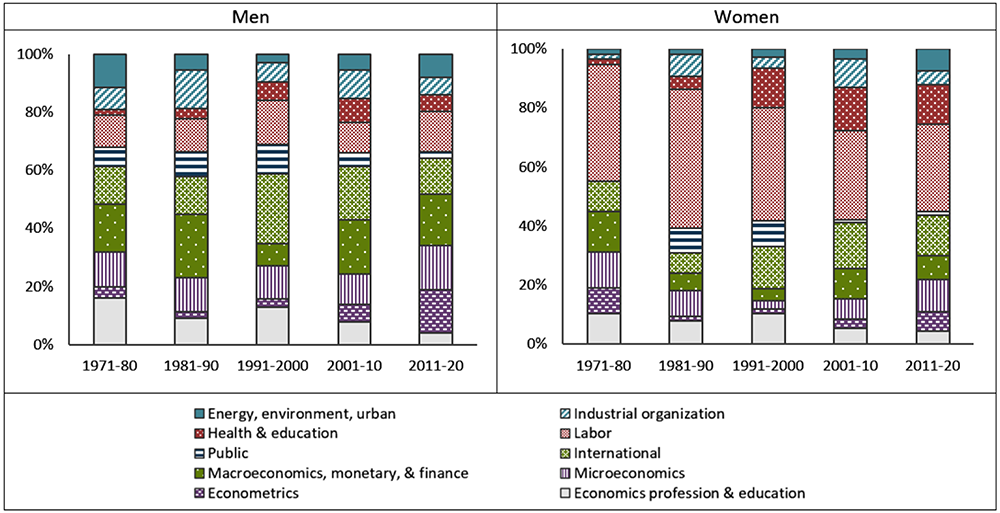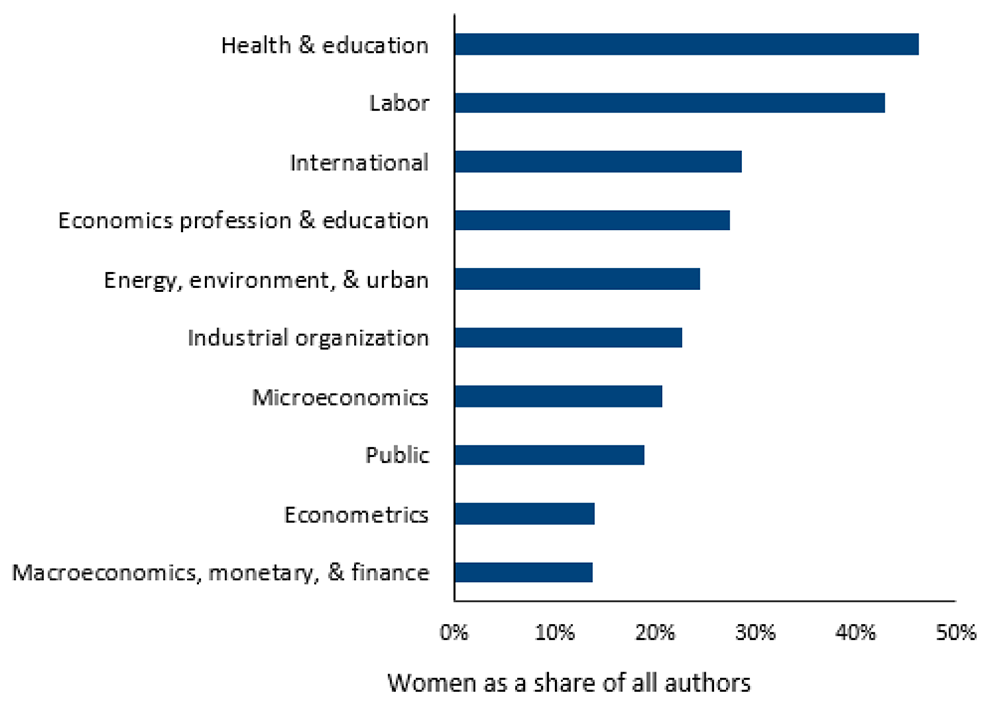FEDS Notes
August 06, 2021
Changes in Women's Representation in Economics: New Data from the AEA Papers and Proceedings
Ellen E. Meade, Martha Starr, and Cynthia Bansak1
The shortage of women and historically underrepresented racial and ethnic groups in the economics profession has received considerable public attention in the past several years.2 The American Economic Association (AEA), the professional organization for economists, has been taking steps to address criticism that the economics discipline is unwelcoming to women and underrepresented minorities.3
In this paper, we discuss an original data set that sheds light on the evolution of published contributions of women economists over a 110-year period. As authors' names do not provide a basis for determining race or ethnicity, the data set we have compiled does not explain trends in the exclusion of historically underrepresented racial or ethnic groups in economics.
As discussed in Ceci and others (2014), Bayer and Rouse (2016), and Lundberg and Stearns (2019), the share of women studying or pursuing careers in economics lags that in other disciplines that also have been traditionally predominantly male, including STEM fields (science, technology, engineering, and math).4 For the past three decades, about one-third of undergraduates earning bachelor's degrees in economics have been women (figure 1). The share of women receiving PhDs rose steadily from about 5 percent in 1966 to around one-third in the mid-2000s, peaking at 35.4 percent in 2013. Since that time, the share of new PhDs awarded to women has averaged 32.9 percent.5 Women's shares of associate and full professors have risen further in recent years, reflecting continued progression through the career pipeline of women who entered earlier—although the levels of these shares remain well below the one-third share of new PhDs.
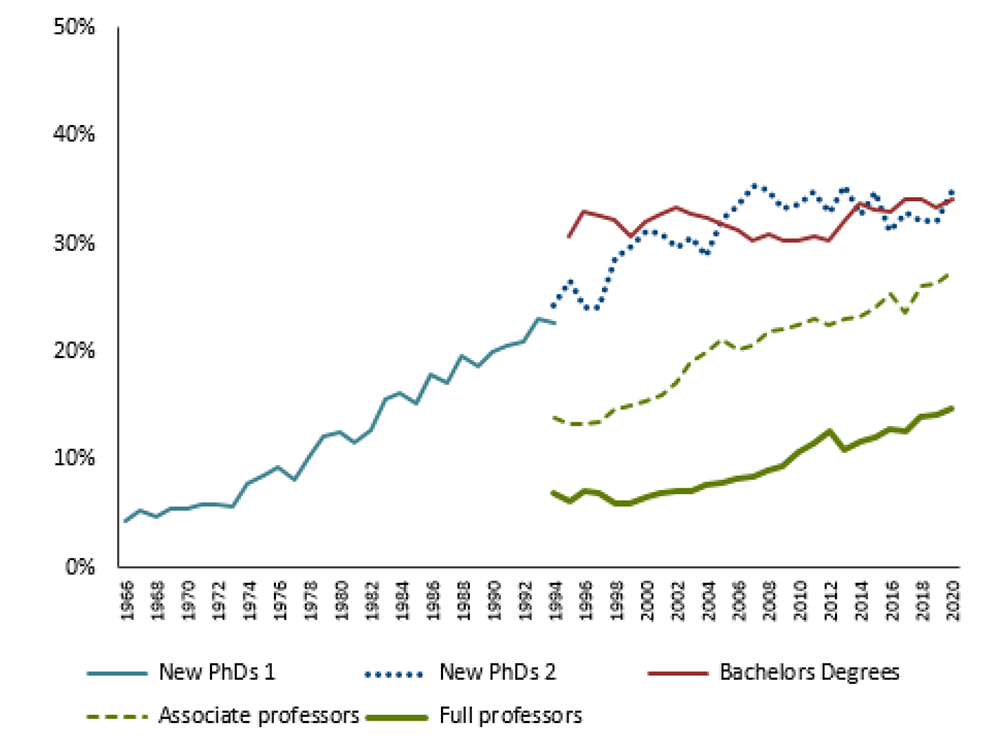
Source: Chevalier (2020) for all series except New PhDs 1, which is from National Center for Science and Engineering Statistics (2011).
In addition to research on the pipeline for women in economics, there is a lengthy literature on gender gaps in pay, publications, and promotion in the economics profession.6 More recent scholarship has explored factors that could affect women's study of economics or their career progress as professional economists, including mentorship programs for new PhDs; professional networks or membership in prestigious groups such as the NBER; the referee process for published work; citations of women's work; the environment at professional seminars; differences in levels of confidence between men and women; and gendered language in online professional forums.7
Our data set is collected from the Papers and Proceedings (P&P), an annual volume of the proceedings of the AEA annual meetings, which has been published since 1911.8 Presenting research at the AEA annual meetings is a high-profile and highly coveted privilege. While the format for the annual meetings and the number of presentations have changed through the years, economists gain distinction from inclusion in the annual meeting program (organized by the AEA president-elect) and additional distinction if their paper is published in the annual P&P volume.9 Thus, a data set cataloguing the 110 years of publications in the annual proceedings volume provides insight into women's position in the economics profession, as well as differences between men and women with respect to coauthoring patterns, institutional affiliations, and research fields. The data set has been posted online together with this paper.
Although our data set spans more than a century, this paper focuses mostly on changes since the early 1970s. In 1971, the AEA established the Committee for the Status of Women in the Economics Profession (CSWEP), which was intended "to eliminate discrimination against women, and to redress the low representation of women, in the economics profession."10 The sessions at the annual meetings that CSWEP has organized since then have provided important opportunities for women economists to present their work and potentially have it published in the P&P.11 As the share of women earning PhDs in economics has increased over the decades since CSWEP was founded, women's representation in the annual P&P issue has also risen in the non-CSWEP sessions.
The key trends that emerge from our data set are as follows:
- Women's share of contributions to the P&P has risen steadily over time, although at an average of 26.4 percent in 2011–20, it remains well below women's one-third share of new PhDs in economics.12 Unlike the stall shown in some other measures of women's representation in economics, the share of women contributing to the P&P has continued to rise, more or less in line with their rising shares of associate and full professors.13
- Although CSWEP played a major role in increasing women's representation in the P&P in the 1970s and 1980s, the increases in representation over the past 20 years have occurred outside of CSWEP-organized sessions.
- Coauthorship is booming, with the share of P&P papers having four or more authors rising especially rapidly. P&P papers written by mixed-gender teams are also increasing in relative importance.
- In terms of institutional affiliations, men contributing to the P&P are more likely to work at top U.S. research universities, while women are more likely to work at other U.S. universities or colleges or in government (including at the Federal Reserve).
- There are significant differences in the research fields of men's and women's contributions to the P&P. While gender gaps have narrowed over time, women remain overrepresented in sessions in labor and health and education, and rare in sessions on macroeconomics, monetary policy, finance, and econometrics.
In the next section, we outline the collection methods and coding of variables in our data set. After that, we document the key trends enumerated above.
The Data Set
AEA Papers & Proceedings Data Set, 1911-2020 (XLSX)
Compilation of the data set was a team effort led by the authors with help from research assistants and multiple layers of checks intended to ensure accuracy. Our data set comprises published contributions to the P&P from 1911 through 2020. Over this period, the P&P issues included 2,228 sessions with a total of 6,037 papers, and 6,973 individuals (5,851 men and 1,121 women), who listed a total of 1,367 unique institutional affiliations. Session and paper titles and authors' names were taken from the tables of contents of the P&P issues, accessed through JSTOR or the AEA's website.14 The variable "role" in the data set records the person's contribution type (paper, discussants' remarks on papers, roundtable, or address). If the contribution is a paper, the paper's total number of authors is recorded in the "num_auth" field.
Authors' genders were coded as man, woman, or unable to determine/not known. Individuals with names that have common, standard gender associations were coded as that gender. When we encountered names used by both genders or that were unfamiliar to us, we used internet information (especially university websites) to locate the individual, then used biographical information, descriptions of people's research activities that used gendered pronouns, photos, or all of these means to determine the person's apparent gender identification. Initial coding by research assistants (who were given detailed instructions in coding procedures) was checked by one of the authors with a second-round check performed by another author.15 With the abundance of information available on the internet, we were able to determine apparent gender identification in all but one case.16
We used the archive of CSWEP newsletters to identify papers published in the P&P that were presented in sessions organized by CSWEP.17
Information on authors' institutional affiliations was taken from footnotes in individual articles. For each author, we coded a "primary institution"—generally the first-listed institution for authors listing multiple affiliations.18 We also categorized institutions into six types: major U.S. research universities; 19 other U.S. universities and colleges; federal, state, and local U.S. government agencies (including the Federal Reserve Board and Federal Reserve Banks); think tanks and other U.S.-based research organizations; foreign academic and non-academic institutions as well as international organizations (such as the World Bank and International Monetary Fund); and "other" institutions, including companies, trade associations, consulting firms, and so on.20
Finally, to classify the subject matter of P&P contributions, we categorized sessions into 10 broad fields using a simplified version of the current Journal of Economic Literature (JEL) classification code system. The field category is assigned to the session, rather than the paper, on the grounds that the choice exercised by the program chair pertains to the topic of the session rather than the specific paper the author(s) produced; generally, the field assigned to the session would apply to the paper as well.21
What Does the Data Set Tell Us?
In the early years when P&P contributions were a mix of papers, discussants' remarks, roundtables, and addresses, an average of about 50 people contributed to the P&P each year. In the 1950s, the composition shifted to 17 to 19 sessions of 2 to 4 papers, which had generally been presented in the same session at the AEA meetings; discussants' comments were published along with papers. The average number of contributors per year was about 100 in the 1950s and 1960s. During the 1970s, publication of discussants' comments was phased out. Since the 1980s, the P&P has consisted of short papers in topically related sessions, with an invited distinguished address at the outset of the issue.
The average number of contributors to the P&P has risen steeply over the past 40 years, reflecting increases in the number of papers published and, as discussed in the next section, a substantial shift from sole-authored to coauthored work (figure 2). Between 2011 and 2020, an average of 279 people authored or coauthored papers in the P&P each year.
Rising representation of women
Before the 1970s, women were rare contributors to the P&P (figure 3). From 1911–40, an average of one woman per year contributed. Over the subsequent three decades, two or three women per year contributed, but their share of total contributors remained minimal at 2–3 percent. Beginning in the 1970s, women's representation began rising, with each decade having a higher average number and larger share than the previous one. In 2011–20, an average of 75 women contributed each year to the P&P, representing 26.4 percent of all contributors. This is well below women's share of new PhDs in economics over these years, which averaged 33.3 percent, but is in line with women's share of associate professors in departments with doctoral programs, which averaged 24.4 percent.22
The role of CSWEP
In the first 10 years after CSWEP began including papers in the P&P, 40 percent of women's contributions to the P&P came via the CSWEP sessions (figure 4).23 In the most recent 20 years, however, the relative importance of CSWEP in women's representation has fallen steadily, so that in 2016–20, women's contributions via CSWEP sessions averaged 16.6 percent of their annual total. The average number of women contributing to the P&P via a CSWEP session has held steady at around 12 in the past two decades, while the average number of women contributing via other sessions rose from 22 in 2001–05 to 72 in 2016–20.
Coauthorship patterns
In general, sole authored papers have evolved from being the norm in the 1970s to being relatively uncommon (figure 5). Over 75 percent of papers were sole authored in 1971–80 versus only 18.6 percent in 2011–20. Over this period the average number of authors per paper has risen from 1.3 to 2.5. Papers with 3 or more coauthors have increased substantially in relative importance, rising from 10 percent of all papers in 1991–2000 to 44 percent in 2011–20. The share of papers with 4+ coauthors has more than doubled over the past two decades, representing 15 percent of the total in 2011-20.
The percentage of papers written by mixed-gender teams that include at least one woman and one man also rose substantially over the period (figure 6). In 1971-80, 91 percent of papers had male authors only; by 2011-20, this share had fallen to 53 percent. Over the same years, papers by mixed-gender teams rose from 2 to 35 percent.
Since the mid-1990s, men have most commonly contributed to the P&P via a coauthored paper with other men only, whereas women have most commonly contributed via a mixed-gender team (figure 7). However, for both men and women, the share contributing to the P&P via a mixed-gender team has increased steadily over time: In 2011–20, 35 percent of men and 65 percent of women contributed to the P&P via a mixed-gender team.
Institutional affiliations
Fairly consistently over time, almost half of all P&P contributors have come from top U.S. universities (figure 8). As participation in the AEA meetings has globalized, so have contributions to the P&P: In 1971–80, 6 percent of P&P authors worked for foreign or international institutions; by 2011–20 the share had risen to 22 percent. Over the same period, authors based at other U.S. universities and colleges, U.S. think tanks and research organizations, and "other" U.S. institutions, including consulting companies and private firms, saw their shares fall. The share of authors from U.S. federal, state, and local governments and the Federal Reserve has held steady at around 6 percent.
While trends in institutional affiliations are largely the same for men and women, men and women who contribute to the P&P are distributed differently across institutions (figure 9). About half of all men who contribute to the P&P are based at a top U.S. university, compared with about 40 percent of women. The share of men based at U.S. universities and colleges outside the top group has been 18–26 percent since the 1970s, compared with 32–39 percent for women. These shares are consistent with CSWEP data and other research showing that female new PhDs are less likely to place at a top research university than their male classmates.
Research fields
The changing composition of research fields in the P&P contributions reflects major policy issues of the day and the changes in relative importance of given research fields in the economics discipline, not to mention the interests of the AEA president-elect responsible for organizing the annual meeting program. The data set provides evidence of booms in specific fields at particular times—for instance, energy markets in the 1970s, inflation and monetary policy in the 1980s, emerging-market financial crises in the 1990s, and the Global Financial Crisis and Great Recession in 2008-13. Figure 10 depicts the waxing and waning in importance of different fields of economic research in the P&P. In 2011–20, for example, the share of papers in econometrics (which includes papers on data, statistics, and quantitative methods) increased because of a surge in sessions on big data, data science, machine learning, experimental methods, and matching models.
Previous research has found differences in the research fields that men and women economists work in.24 Similar differences between men and women are apparent in the research fields of their P&P papers, although these gender differences have narrowed somewhat over time (figure 11). In the 1980s and 1990s, over half of all women contributing to the P&P did so via sessions in labor economics and health and education, whereas about one-fifth of men's contributions were in these fields. Conversely, men's shares have been substantially larger than those of women in macroeconomics, monetary economics, and finance and in international trade and finance, growth, and development. However, the fields of women's contributions to the P&P have become more diversified over time. In the 1980s, 51 percent of women's contributions were in labor and health and education; in the 2010s, this share was 43 percent.
In 2011–20, women's shares of authors in some research fields were substantially higher or lower than their average authorship share of 26.4 percent (figure 12). While women accounted for 43 and 46 percent of all authors of papers in labor economics and in health and education, respectively, they represented only 14 percent of all authors of papers in both econometrics and in macroeconomics, monetary economics, and finance. In other fields, however, women's representation is similar to their representation in the P&P overall.25 Underrepresentation of women in macroeconomics, monetary economics, and finance has been noted by other researchers and is an important concern, given the recognition that diversity and inclusion in policymaking environments leads to more robust decisions and higher-quality outcomes.26
References
American Economic Association (2019). AEA Professional Climate Survey: Final Report. Nashville: AEA, September.
Bartlett, Robin L. (1998). "CSWEP: 25 Years at a Time," Journal of Economic Perspectives, vol. 12 (4), pp. 177–83.
Bayer, Amanda, and Cecilia Elena Rouse (2016). "Diversity in the Economics Profession: A New Attack on an Old Problem," Journal of Economic Perspectives, vol. 30 (4), pp. 221–42.
Bayer, Amanda, and David W. Wilcox (2019). "The Unequal Distribution of Economic Education: A Report on the Race, Ethnicity, and Gender of Economics Majors at U.S. Colleges and Universities," Journal of Economic Education, vol. 50 (3), 299–320.
Beneito, Pilar, J. E. Boscá, Javier Ferri, and Manu García (2018). "Women across Subfields in Economics: Relative Performance and Beliefs (PDF)," FEDEA Working Papers 2018-06. Madrid, Spain: Fundación de Estudios de Economía Aplicada, June.
Card, David (2021). "Foreword," AEA Papers and Proceedings, vol. 111, pp. xi–xii.
Card, David, Stefano DellaVigna, Patricia Funk, and Nagore Iriberri (2020). "Are Referees and Editors in Economics Gender Neutral?" Quarterly Journal of Economics, vol. 135 (1), pp. 269–327.
Ceci, Stephen J., Donna K. Ginther, Shulamit Kahn, and Wendy M. Williams (2014). "Women in Academic Science: A Changing Landscape," Psychological Science in the Public Interest, vol. 15 (3), pp. 75–141.
Chari, Anusha, and Paul Goldsmith-Pinkham (2017). "Gender Representation in Economics across Topics and Time: Evidence from the NBER Summer Institute." NBER Working Paper Series 23953. Cambridge, Mass.: National Bureau of Economic Research, October.
Chevalier, Judith (2020). The 2020 Report of the Committee on the Status of Women in the Economics Profession. Nashville: American Economic Association, December.
Chevalier, Judith (2021). "Report: Committee on the Status of Women in the Economics Profession (CSWEP)," AEA Papers and Proceedings, vol. 111, pp. 742–63.
Committee for the Status of Women in the Economics Profession (1997). "CSWEP: Mission Statement," webpage.
Committee for the Status of Women in the Economics Profession (2020). "CWSEP News Archives," webpage.
Committee for the Status of Women in the Economics Profession (n.d.). "CSWEP: Sessions Policy," webpage.
Doleac, Jennifer L., Erin Hengel, and Elizabeth Pancotti (2021). "Diversity in Economics Seminars: Who Gives Invited Talks?" AEA Papers and Proceedings, vol. 111, pp. 55–59.
Dupas, Pascaline, Alicia Sasser Modestino, Muriel Niederle, Justin Wolfers, and the Seminar Dynamics Collective (2021). "Gender and the Dynamics of Economics Seminars," NBER Working Paper Series 28494. Cambridge, Mass.: National Bureau of Economic Research, February (revised May).
Fortin, Nicole, Thomas Lemieux, and Marit Rehavi (2021). "Gender Differences in Fields of Specialization and Placement Outcomes among PhDs in Economics," AEA Papers and Proceedings, vol. 111, pp. 74–79.
Ginther, Donna K., and Rina Na (2021). "Does Mentoring Increase the Collaboration Networks of Female Economists? An Evaluation of the CeMENT Randomized Trial," AEA Papers and Proceedings, vol. 111, pp. 80–85.
Ginther, Donna K., Janet M. Currie, Francine D. Blau, and Rachel T. A. Croson (2020). "Can Mentoring Help Female Assistant Professors in Economics? An Evaluation by Randomized Trial," AEA Papers and Proceedings, vol. 110, pp. 205–09.
Ginther, Donna K., and Shulamit Kahn (2004). "Women in Economics: Moving Up or Falling Off the Academic Career Ladder?" Journal of Economic Perspectives, vol. 18 (3), pp. 193–214.
Ginther, Donna, and Janet Stefanov (n.d.), "Annotated Bibliography on Research Related to Women in the Economics Profession," webpage.
Harrison, David (2019). "Female Economists, in Survey, Cite Gender Discrimination," Wall Street Journal, March 18.
Hinshaw, Elton C. (1992). "Minutes of the Meeting of the Executive Committee in New Orleans, LA, January 4, 1992," American Economic Review, vol. 82 (2), pp. 583–87.
Johnson, William R., and Ginny Herbert (2021). "Editors' Introduction," AEA Papers and Proceedings, vol. 111, p. xiii.
Kahn, Shulamit (1993). "Gender Differences in Academic Career Paths of Economists," American Economic Review, vol. 83 (2), pp. 52–56.
Kleemans, Marieke, and Rebecca L. Thornton (2021). "Who Belongs? The Determinants of Selective Membership into the National Bureau of Economic Research," AEA Papers and Proceedings, vol. 111, pp. 117–22.
Koffi, Marlène (2021). "Gendered Citations at Top Economic Journals," AEA Papers and Proceedings, vol. 111, pp. 60–64.
Lundberg, Shelly, and Jenna Stearns (2019). "Women in Economics: Stalled Progress," Journal of Economic Perspectives, vol. 33 (1), pp. 3–22.
National Center for Science and Engineering Statistics (2011). Science and Engineering Degrees: 1966–2008. Alexandria: National Science Foundation, June.
Rousseau, Peter L. (2017). "Minutes of the Meeting of the Executive Committee: Chicago, IL, January 5, 2017," American Economic Review, vol. 107 (5), pp. 689–98.
Rousseau, Peter L. (2018). "Minutes of the Meeting of the Executive Committee: Chicago, IL, April 14, 2017," AEA Papers and Proceedings, vol. 108, pp. 621–27.
Siegfried, John (2007). "Minutes of the Meeting of the Executive Committee in Chicago, IL, January 4, 2007," American Economic Review, vol. 82 (2), pp. 529–33.
Sarsons, Heather and Guo Xu (2021). "Confidence Men? Evidence on Confidence and Gender Among Top Economists," AEA Papers and Proceedings, vol. 111, pp. 65–68.
Wu, Alice H. (2020). "Gender Bias in Rumors Among Professionals: An Identity-Based Interpretation," Review of Economics and Statistics, vol. 102 (5), pp. 867–80.
1. The authors' affiliations are the Division of Monetary Affairs, Federal Reserve Board; Greylock McKinnon Associates; and the Department of Economics, St. Lawrence University, respectively. The views expressed in this note are those of the authors and should not be interpreted as reflecting the views of the Board of Governors or the Federal Reserve System. The authors thank Michael Palumbo, Karen Pence, and David Wilcox for helpful comments; Megan McCall, Marlee Patterson, and Thermidor Pierre for excellent research assistance; Kenny Rogers and Jeremy Scheid for help at an earlier stage of this project; Luke Morgan for preparation of 508 materials; and Forrest McCluer for help with compiling the data. Any errors in this paper or data set are the responsibility of the authors. Return to text
2. See, for example, Harrison (2019). Return to text
3. These steps include formulating a code of professional conduct and establishing an ombudsperson (https://www.aeaweb.org/about-aea); conducting a climate survey (American Economic Association, 2019); and setting up the Committee on the Status of LBGTQ+ Individuals in the Economics Profession and the Task Force on Best Practices for Professional Conduct in Economics. Return to text
4. Panels A (B) in figure 1 (Bayer and Rouse, 2016) show a gap on the order of 25 (30) percentage points between doctorate (bachelor's) degrees awarded to women in STEM subjects and economics in recent years. Return to text
5. See also Chevalier (2021) and Lundberg and Stearns (2019). Return to text
6. See, for example, Kahn (1993), Bartlett (1998), Ginther and Kahn (2004), and Ginther and Stefanov (2021) and the references cited therein. Return to text
7. See, for example, Ginther and others (2020) and Ginther and Na (2021) on mentoring; Chari and Goldsmith-Pinkham (2017) and Kleemans and Thornton (2021) on professional networks; Card and others (2020) on the referee process; Koffi (2021) on citations; Doleac and others (2021) and Dupas and others (2021) on seminars; Sarsons and Xu (2021) on confidence; and Wu (2020) on language in online professional forums. Return to text
8. Over the years, the number of journals published by the American Economic Association has expanded from 1 to 9. From 1911 to 2017, the papers and proceedings were published in a special issue of the American Economic Review (AER), the association's flagship journal (generally the March issue before 1945 and the May issue thereafter). In 2018, the AEA spun the P&P issue off into a new, separate publication called the AEA Papers and Proceedings. The spinoff reflected a desire by the members of the AEA's Executive Committee to make clear that the non-refereed P&P articles are not subject to the same professional standards as the refereed articles in the other AER issues. In addition, to accommodate the rising volume of papers submitted to the AER, the Executive Committee opted to increase the frequency of publication from 5 issues per year to 12; moving the P&P to a new journal freed up an extra issue for refereed papers. See Rousseau (2017 and 2018). Return to text
9. The lion's share of publications in the P&P are "invited." The AEA program chair for the year—the president-elect of the AEA—and a program committee working with the program chair organize the AEA program for the annual meetings. Most AEA sessions are selected from paper proposals contributed by AEA members. Some are organized by program committee members in their fields of expertise, with authors in these sessions invited to publish their papers in the P&P. See Card (2021) and Johnson and Herbert (2021). Return to text
10. See the CSWEP Mission Statement (1997). CSWEP also monitors the role of women in the profession through annual surveys of economics departments. See Chevalier (2020). Return to text
11. From 1975 to 1989, the AEA allotted one session of P&P papers to CSWEP; a CSWEP committee then selected three to four papers from among those presented in CSWEP sessions at the AEA meetings for publication in the P&P. Since 1990, CSWEP has published two sessions of P&P papers—one gender-related and another on a non-gender topic chosen from papers on the CSWEP program that year (Hinshaw, 1992; Siegfried, 2007; CSWEP, n.d.). Return to text
12. In the early years of the AEA, the publications in the P&P were a mix of papers, discussants' remarks, roundtables, and addresses. The term "contributions" is intended to reflect this mix. Since the 1970s, virtually all P&P contributions have been short articles, except for an annual distinguished lecture known until 2020 as the Richard T. Ely lecture. Return to text
13. Lundberg and Stearns (2019). Return to text
14. Papers and Proceedings issues of the American Economic Review (1911–2017) and AEA Papers and Proceedings (2018-2020), https://www.aeaweb.org/journals/pandp/issues [Copyright American Economic Association; reproduced with permission of the American Economic Review]. Return to text
15. In the early years of the data, many authors published using initials, and names now commonly used by women were then commonly used by men; in these cases, we used biographic information found in JSTOR pieces, on the internet, or both to determine gender. Return to text
16. We recognize that gender is non-binary and may change, and that our coding methods risk oversimplification or misclassification of an author's identifications. Return to text
17. See CSWEP News Archives (2020). Return to text
18. To facilitate analysis, we recorded affiliations with academic institutions in terms of the university or college, rather than schools or departments within it. For authors who reported multiple affiliations (such as a university and NBER or CEPR), the variable "prim_institution" is their first-listed institution and/or the institution indicated by their email address. All affiliations listed by authors are recorded in the "full_institution" field. Return to text
19. We defined "major U.S. research universities" as those found consistently in the top 20-25 in rankings of economics departments from the 1970s to the present; the INST_SOURCE tab in the data spreadsheet lists the sources used. There were 21 universities in this group, which are listed in the INST_TYPE tab of the data spreadsheet. Return to text
20. The INST_TYPE tab in the data spreadsheet lists institutions in each category. Return to text
21. The fields include the following JEL categories (based on the current codes): Economics profession and education (A,B,N,P); Econometrics (C); Microeconomics (D,Z); Macro, money, and finance (E,G); International (F,O except O3); Public (H); Labor (J); Health and education (I); Industrial organization (L,O3,K,M); and Energy, environment, urban (Q,R). The VARIABLE DEFS tab in the data spreadsheet provides additional detail. Return to text
22. See figure 1. Return to text
23. Both men and women contribute to the P&P via CSWEP papers. Since the 1970s, women's share of all authors of CSWEP-contributed papers has remained around 75 percent. Return to text
24. See Beneito and others (2018); Chari and Goldsmith-Pinkham (2017); Fortin, Lemieux, and Rehavi (2021); Lundberg and Stearns (2019). Return to text
25. Economics profession and education; International; Industrial organization; and Energy, environment, urban. Return to text
26. Footnote 24 provides references to other studies with similar findings about representation in macro, money, and finance. See Bayer and Rouse (2016) and Bayer and Wilcox (2019) regarding the benefits associated with diversity and inclusion. Return to text
Meade, Ellen E., Martha Starr, and Cynthia Bansak (2021). "Changes in Women's Representation in Economics: New Data from the AEA Papers & Proceedings," FEDS Notes. Washington: Board of Governors of the Federal Reserve System, August 06, 2021, https://doi.org/10.17016/2380-7172.2975.
Disclaimer: FEDS Notes are articles in which Board staff offer their own views and present analysis on a range of topics in economics and finance. These articles are shorter and less technically oriented than FEDS Working Papers and IFDP papers.
